William Nowland Van Powell (1904–1977), sometimes known professionally as William Van Powell[1] or Nowland Van Powell[2] was an architect, painter, and historian from Memphis, Tennessee.[3]
Architect
In the 1930s, the Greyhound Lines bus company built many bus stations in the then-popular Streamline Moderne style. William Nowland Van Powell designed at least four of them. Working with George Mahan, Jr. in 1939, he was the architect of the Greyhound Bus Station in Jackson, Mississippi.[4] Working with Ben Watson White, he designed the Blytheville Greyhound Bus Station in 1937.[5]
He is also credited as the designer of two nearly-identical Greyhound Half-Way Stations: the Greyhound Half-Way House in Waverly, Tennessee,[6] that has been preserved, and another in Flat River, Missouri that has been substantially remodeled into a laundromat.[7]
Van Powell worked in other architectural styles for other clients. In 1927, he was the architect of the Venetian-inspired Memphis Steam Laundry building, formerly at 941 Jefferson Ave., Memphis, demolished in 2009.[2]
Along with Henry Ehrensing, he was the architect of the Grand Palace Hotel, New Orleans (built originally as Claiborne Towers), and promoted by its developer as "likely to be one of the greatest buildings the South has ever seen."[8] At the time, Claiborne Towers was the South's largest apartment project, with a planned 1036 units that included air conditioning.[9]
He was also the architect of Memphis' Farnsworth Building (now the Memphis Business Journal Building), which was added to the National Register of Historic Places in 1983.[1][10]
Buildings designed
.jpg.webp) Old Greyhound Bus Station (Jackson, Mississippi) December 1939, showing George Mahan, Jr. and Nowland Van Powell, Architects (MDAH Photo)
Old Greyhound Bus Station (Jackson, Mississippi) December 1939, showing George Mahan, Jr. and Nowland Van Powell, Architects (MDAH Photo)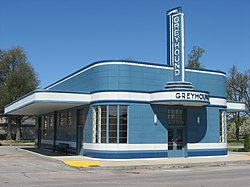
 Greyhound and West Ridge bus station, Erie PA (postcard c. 1940)[11]
Greyhound and West Ridge bus station, Erie PA (postcard c. 1940)[11]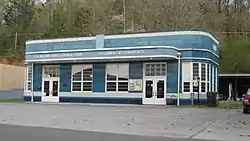 Greyhound Half-Way House, Waverly, Tennessee (2014 photo)
Greyhound Half-Way House, Waverly, Tennessee (2014 photo)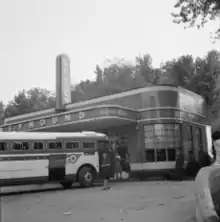 A Greyhound bus stops at the Half-Way House, September 1943
A Greyhound bus stops at the Half-Way House, September 1943 Greyhound Half-Way Station, Flat River, Missouri. 1940s postcard view.
Greyhound Half-Way Station, Flat River, Missouri. 1940s postcard view. Greyhound Half-Way Station, Jackson, Tennessee[12]
Greyhound Half-Way Station, Jackson, Tennessee[12] Fairview Junior High School, Memphis, designed c. 1930 while employed at Firm of Edward Lee Harrison
Fairview Junior High School, Memphis, designed c. 1930 while employed at Firm of Edward Lee Harrison
NRHP 87000447 Claiborne Towers, New Orleans, during its December 2011 demolition
Claiborne Towers, New Orleans, during its December 2011 demolition.png.webp) Postcard view (c. 1930) of the Memphis Steam Laundry, 941 Jefferson Ave, Memphis TN, shortly after its completion in 1927
Postcard view (c. 1930) of the Memphis Steam Laundry, 941 Jefferson Ave, Memphis TN, shortly after its completion in 1927
Painter, Historian, Author
Van Powell was the author of The American Navies of the Revolutionary War,[13] a collection of his paintings, with descriptive notes by the artist published in 1974 by G. P. Putnam's Sons, New York.[14]
 Continental Navy Ship Columbus signed WNVP)
Continental Navy Ship Columbus signed WNVP)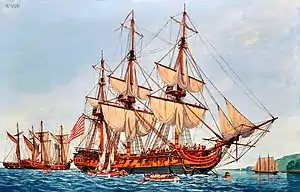 USS Confederacy signed WNVP
USS Confederacy signed WNVP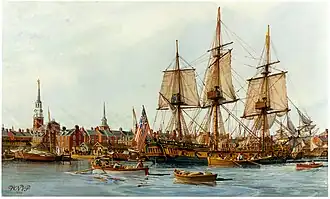 Lieutenant John Paul Jones raising the "Grand Union" flag as Alfred was placed in commission at Philadelphia, Pennsylvania, 3 December 1775 by W. Nowland Van Powell
Lieutenant John Paul Jones raising the "Grand Union" flag as Alfred was placed in commission at Philadelphia, Pennsylvania, 3 December 1775 by W. Nowland Van Powell.jpg.webp) Continental Sloop Providence (1775-1779) signed WNVP
Continental Sloop Providence (1775-1779) signed WNVP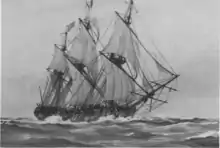
References
- 1 2 "Farnsworth Building, Memphis". gigapan.com. Retrieved 5 April 2018.
- 1 2 Lauderdale, Vance. "The Memphis Steam Laundry". Memphis Flyer. Retrieved 5 April 2018.
Why does our fine city have such a penchant for tearing down some of the coolest-looking buildings ever constructed? Case in point, the Venetian-inspired Memphis Steam Laundry building, designed by noted architect Nowland Van Powell
- ↑ McNabb, W. R. (1977). The Architecture of William Nowland Van Powell: Southern Classicist, 1904-1977. Retrieved 5 April 2018.
- ↑ "Greyhound Bus Station, December 22, 1939". Flickr. Retrieved 5 April 2018.
George Mahan Jr. - Nowland Van Powell Architects, Memphis Tenn.
- ↑ "Asset Detail". npgallery.nps.gov. Retrieved 9 April 2018.
- ↑ "NRHP Asset Detail". npgallery.nps.gov. Retrieved 8 April 2018.
- ↑ "Missouri Greyhound Bus Stations | RoadsideArchitecture.com". roadarch.com. Retrieved 9 April 2018.
- ↑ Barrow, Bill (13 November 2011). "Failed hotel at Canal and Claiborne will leave decades of lost potential in the dust when it blows up". NOLA.com. The Times-Picayune. Retrieved 5 April 2018.
http://www.nola.com/business/index.ssf/2011/11/failed_hotel_at_canal_and_clai.html
{{cite news}}: External link in|quote= - ↑ Rylance, Keli (14 January 2011). "docomomo_nola: Claiborne Towers 1950". docomomo_nola. Retrieved 5 April 2018.
In December 1950, architects William Nowland Van Powell (1904-1977) and Henry Ehrensing (1907-1985) received attention for their design of a new luxury apartment complex to be located at the intersection of South Claiborne Avenue and Canal Street (bounded by Cleveland and S. Derbigny). At the time, Claiborne Towers was the South's largest apartment project, with a planned 1036 units that included air conditioning. Construction of the 17-story $10 Million building had begun in April of 1950, after a lease agreement for the site was negotiated with Tulane University. By 1952, Claiborne Towers featured a beauty shop, lingerie boutique, cleaners, and a lounge on its ground floor. Its lobby was apportioned with terrazzo flooring and black walnut panels, and a mural depicting the progress of New Orleans was planned for the 62-ft wall expanse above the structure's Otis elevator bank.
- ↑ "Historic Memphis Buildings ...and notable Businesses". historic-memphis.com. Retrieved 5 April 2018.
- ↑ "Pennsylvania Greyhound Bus Stations | RoadsideArchitecture.com". www.roadarch.com. Retrieved 10 April 2018.
- ↑ "Asset Detail". npgallery.nps.gov. Retrieved 10 April 2018.
- ↑ Powell, Nowland van (1974). The American Navies of the Revolutionary War: Painting by Nowland Van Powell. Putnam's Sons. ISBN 9780399111839. Retrieved 5 April 2018.
- ↑ "9780399111839 - The American Navies of the Revolutionary War: Paintingsby Nowland Van Powell". www.biblio.com. Retrieved 5 April 2018.